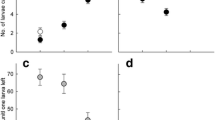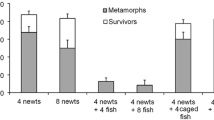Summary
Cannibalism is likely to operate as a form of population control in dragonfly larvae. I performed aquarium experiments to investigate the effect of foraging activity and zooplankton availability on cannibalism in three dragonfly larvae. Large Cordulia aenea larvae showed low activity, and large Leucorrhinia dubia larvae showed high activity irrespective of zooplankton availability. In contrast, large Coenagrion hastulatum larvae changed from high activity in the absence to low activity in the presence of zooplankton. Small Cordulia aenea larvae were active in the absence of large conspecifics irrespective of zooplankton availability. In the presence of large conspecifics they showed a reduced activity when zooplankton were present. Small L. dubia larvae showed high activity and small Coenagrion hastulatum larvae low activity irrespective of pressence or absence of zooplankton and large conspecifics. In all three species cannibalism was highest in the absence of zooplankton. In the absence of zooplankton cannibalism was low in Coenagrion hastulatum compared to the other two species. On the contrary, in the presence of zooplankton, cannibalism did not differ between the three species.
Similar content being viewed by others
References
Abrams PA (1984) Foraging time optimization and interactions in food webs. Am Nat 124: 80–96
Baker RL, Clifford HF (1981) Life cycles and food of Coenagrion resolutum (Coenagrionidae: Odonata) and Lestes disjunctus (Lestidae: Odonata) populations from the boreal forest of Alberta, Canada. Aquat Insects 3: 179–191
Benke AC (1978) Interactions among coexisting predators—A field experiment with dragonfly larvae. J Anim Ecol 47: 335–350
Benke AC, Benke SS (1975) Comparative dynamics and life histories of coexisting dragonfly populations. Ecology 56: 302–317
Benke AC, Crowley PH, Johnson DM (1982) Interactions among coexisting larval Odonata: an in situ experiment using small enclosures. Hydrobiologia 94: 121–130
Crowley PH, Dillon PM, Johnson DM, Watson CN (1987) Intraspecific interference among larvae in a semivoltine dragonfly population. Oecologia 71: 447–456
Fischer Z (1960) Cannibalism among the larvae of the dragonfly Lestes nympha Selys. Ekol Pol, Series B 7: 33–39.
Formanowicz DR Jr (1982) Foraging tactics of larvae of Dytiscus verticalis (Coleoptera: Dytiscidae): the assessment of prey density. J Anim Ecol 51: 757–767
Gabriel W (1985) Overcoming food limitation by cannibalism: A model study on cyclopoids. Arch Hydrobiol Beih 21: 373–381
Hassell MP (1978) The dynamics of arthropod predator-prey systems. Princeton University Press, Princeton
Holling CS (1966) The functional response of invertebrate predators to prey density. Mem Entomol Soc Can 48: 1–86
Holm S (1979) A simple sequentially rejective multiple test procedure. Scand J Statist 6: 65–70
Johansson F (1991) Foraging modes in an assemblage of odonate larvae-effects of prey and interference. Hydrobiologia 209: 79–87
Johansson F (1992) Intra guild predation and cannibalism in odonate larvae: effects of foraging behaviour and zooplankton availability. Oikos (in press)
Johnson DM (1986) The life history of Tetragoneuria cynosura (Say) in Bays Mountain Lake, Tennessee, United States (Anisoptera. Corduliidae). Odonatologica 15: 81–90
Johnson DM, Pierce CL, Martin TH, Watson CN, Bohanan RE, Crowley PH (1987) Prey depletion by odonate larvae: combining evidence from multiple field experiments. Ecology 68: 1459–1465
Johnson DM, Crowley PH, Bohanan RE, Watson CN, Martin TH (1985) Competition among dragonflies: a field enclosure experiment. Ecology 66: 119–128
Landahl HD, Hansen BD (1975) A three stage population model with cannibalism. Bull Math Biol 37: 11–17
Ludwig D, Rowe L (1990) Life history strategies for energy gain and predator avoidance under time constraints. Am Nat 135: 686–707
Macan TT (1974) Twenty generations of Pyrrhosoma nymphula (Sulzer) and Enallaqma cyathigerum Charpienter (Zygoptera: Coenagrionidae). Odonatologica 3: 107–119
Merrill RJ, Johnson DM (1984) Dietary niche overlap and mutual predation among coexisting larval Anisoptera. Odonatologica 13: 387–406
Polis GA (1980) The effect of cannibalism on the demography and activity of a natural population of desert scorpions. Behav Ecol Sociobiol 7: 25–35
Polis GA (1981) The evolution and dynamics of intraspecific predation. Annu Rey Ecol Syst 12: 225–251
Pritchard G (1964) The prey of dragonfly larvae (Odonata; Anisoptera) in ponds in Northern Alberta. Can J Zool 42: 785–800
Robinson JV, Wellborn GA (1987) Mutual predation in assembled communities of odonate species. Ecology 68: 912–927
Sih A (1982) Foraging strategies and the avoidance of predation by an aquatic insect, Notonecta hoffmanni. Ecology 63: 786–796
Sih A (1984) Optimal behaviour and density-dependent predation. Am Nat 123: 314–326
Thompson DJ (1978) The natural prey of the damselfly, Ischnura elegans (Odonata: Zygoptera). Freshw Biol 8: 377–384
Van Buskirk J (1989) Density dependent cannibalism in larval dragonflies. Ecology 70: 1442–1449
Wilkinson L (1988) SYSTAT: the system for statistics. Systat, Evanston, Ill
Wissinger SA (1988a) Spatial distribution, life history and estimates of survivorship in a fourteen-species assemblage of larval dragonflies (Odonata: Anisoptera). Freshw Biol 20: 329–340
Wissinger SA (1988b) Life history and size structure of larval dragonfly populations. JN Am Benthol Soc 7: 13–28
Wissinger SA (1989) Seasonal variation in the intensity of competition and predation among dragonfly larvae. Ecology 70: 1017–1027
Author information
Authors and Affiliations
Rights and permissions
About this article
Cite this article
Johansson, F. Effects of zooplankton availability and foraging mode on cannibalism in three dragonfly larvae. Oecologia 91, 179–183 (1992). https://doi.org/10.1007/BF00317781
Received:
Accepted:
Issue Date:
DOI: https://doi.org/10.1007/BF00317781




